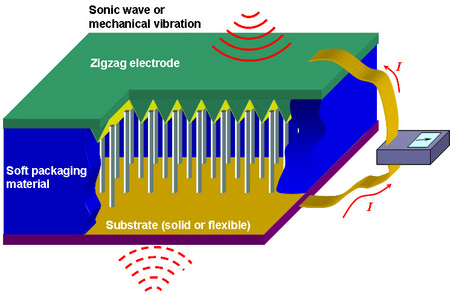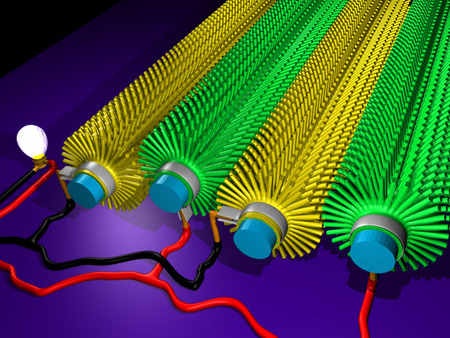Nanotechnology creates the ‘power shirt’
Last updated Feb 16, 2008 — 1656 views Researchers at Georgia Tech are developing a “power shirt” capable of running portable electronic gadgets. Clothing woven with fibers containing microscopic “nanogenerators” will use piezoelectric effects to convert the wearer’s movements into electrical energy.
Researchers at Georgia Tech are developing a “power shirt” capable of running portable electronic gadgets. Clothing woven with fibers containing microscopic “nanogenerators” will use piezoelectric effects to convert the wearer’s movements into electrical energy.
According to Georgia Tech, the nanogenerator-impregnated fibers could also find use in curtains, tents, and other flexible structures, enabling the harvesting of energy from wind motion, sound vibration, or other mechanical energy.
“If we can combine many of these fibers in double or triple layers in clothing, we could provide a flexible, foldable and wearable power source that, for example, would allow people to generate their own electrical current while walking,” says head researcher Zhong Lin Wang, a regents professor in Georgia Tech’s School of Materials Science and Engineering.
The power generation mechanism proposed for use in clothing is based on “nanowire nanogenerators” described by Wang’s team in the April, 2007 issue of Science. According to the team, this technology generates current from arrays of vertically-aligned zinc oxide (ZnO) nanowires that flex beneath platinum-tipped electrodes, and is intended to capture energy from environmental sources such as ultrasonic waves, mechanical vibrations, and blood flow.

Following a year of development, the three millimeter-square nanogenerators reportedly can produce up to 20 millivolts at currents of 800 nanoamperes.

In order to create cloth or other flexible materials containing nanogenerators, pairs of zinc oxide nanowires are embedded in a polymer on DuPont Kevlar fibers, according to the researchers.
One of the fibers in each nanowire pair is coated with gold, to serve as an electrode and to deflect the nanowire tips, according the researchers. Then, the two different types of fibers are paired up and packed together so as to ensure that the gold-coated fibers only come in contact with zinc oxide nanowires, as shown below.

So far, the team says it has successfully produced about 4 mV at 4 nanoamps from a pair of the resulting flexible nanogenerator fibers. Wang estimates that 1 square-meter of fabric made from these fibers could generate as much as 80 mW of power.
Wang notes that before nanogenerator fiber technology can see wide-scale commercial use, however, it needs overcome a key problem. Because zinc oxide is highly sensitive to moisture, the nanowires will need to somehow be protected from being ruined when materials containing them come in contact with water, due to rain, splashes, cleaning processes, etc.
Georgia Tech’s nanogenerator research project is supported by a grant from the U.S. National Science Foundation’s Division of Materials Research.
[Photo source: Georgia Institute of Technology.]